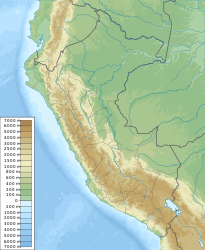Yungay (Peru)
| Yungay | ||
|---|---|---|
|
|
||
| Coordinates | 9 ° 8 ′ S , 77 ° 45 ′ W | |
| Basic data | ||
| Country | Peru | |
| Ancash | ||
| province | Yungay | |
| ISO 3166-2 | PE-ANC | |
| District | Yungay | |
| height | 2458 m | |
| Residents | 7541 (2017) | |
| founding | 4th August 1540 | |
| Website | www.muniyungay.gob.pe (Spanish) | |
|
Christ before Huascarán
|
||
Yungay is a city in the Ancash region of western Peru . It is the capital of the Yungay Province of the same name . Yungay is located 60 km north of the regional capital Huaraz in the Callejón de Huaylas (Valley of the Río Santa ). The population was 7,541 in the 2017 census. 10 years earlier the population was 6,074.
etymology
Yungay means something like "warm valley" ( Yunkay ) in the language of the indigenous people ( Quechua ). The Chilean city of the same name, Yungay , was named after the Battle of Yungay (1839) in Peru.
geography
location
The city of Yungay lies at an altitude of 2,458 m in the interandine long valley of the Rio Santa, which is traversed by the tectonic fault line of the Cordillera Blanca fault . The place is thus in the height of the Tierra Fría , the main settlement area of the Andes . A landscape-defining element of the surroundings are the areas afforested with the allochthonous tree species Eucalyptus and Pinus .
economy
The city is the marketplace and trading center for the entire province. As a central location, Yungay has the provincial administration, a hospital and schools and is also the seat of the only mountain rescue station in Peru. Due to its location in the immediate vicinity of Peru's highest mountain Huascarán , the city is a popular starting point for trekking tours in the Cordillera Blanca . The area around Yungay is one of the most important peach growing areas in Peru.
history
Yungay viejo
The "old" Yungay ("the pearl of the Andes") ( 9 ° 9 ′ 1 ″ S , 77 ° 44 ′ 12 ″ W ) was destroyed on May 31, 1970 together with most of its 19,000 inhabitants (Yungay district) by a massive landslide completely buried under masses of mud and rubble. The neighboring towns of Ranrahirca and Matacoto suffered the same fate . Caused by a very severe earthquake with a magnitude of 7.8 on the Richter scale , large parts of the glaciated northwest flank of the Huascarán massif, the highest point in Peru at 6768 m, detached. About 50 million cubic meters of ice, mud and rock thundered the Quebrada Llanganuco down to the valley with devastating force , jumped over a 200 m high, supposedly protective ridge and poured over almost the entire city area. Only the cemetery on a hill and the huge statue of Christ in its center were spared. 93 people survived here. According to estimates by the United States Geological Survey, the debris avalanche covered about 14.5 km in four minutes before it came to a standstill, which corresponds to an average speed of about 220 km / h. According to various sources, 12,000 to 20,000 people lost their lives; depending on which affected neighboring settlements were included. Only a few remains of the wall and a wrecked bus filled with rocks bear witness to the merciless force of the catastrophe. The area of the destroyed place, covered by an average of five meters thick layer of rubble, was declared a cemetery (sanctuary) in its entire area and remains an awe-inspiring memorial .
Yungay nuevo
Today's Yungay was rebuilt about 1.5 kilometers north of the disaster after the disaster of 1970. It emerged from a camp that was set up by auxiliary workers for supply purposes after the devastating accident of 1970. Original plans by the government in Lima were for reconstruction in a more distant area; However, the survivors and the population of the surrounding area braced themselves against these plans. The steady increase in population in Yungay Nuevo since the 1970s has led to a sharp increase in the settlement area , so that parts of the new city have already been built again near the deposits of the debris avalanche of 1970.
sons and daughters of the town
- Victor Cordero Gonzales (1893–1949), singer and composer
- Luis Armando Bambarén Gastelumendi (* 1928), Catholic clergyman and bishop
Individual evidence
- ↑ a b PERU: Áncash Region: Provinces & Places . www.citypopulation.de. Retrieved December 15, 2019.
Web links
literature
- Lutz Bormann: High ways under the Southern Cross. In: Mountains . No. 88, 1998, pp. 8-26.
- Andreas Haller: Man, City, Mountain. Post-disaster urban development in Yungay, Peru. In: dérive - magazine for urban research . No. 43, 2011, pp. 37-41.
- Gerd Möller: Peru and Bolivia. DuMont Buchverlag , Cologne 1996, ISBN 3-7701-2068-X .
- Alan Murphy: Peru Handbook. Footprint, Bath 1999, ISBN 0-8442-2187-2 .
- Anthony Oliver-Smith: The Martyred City: Death and Rebirth in the Andes. University of New Mexico Press , Albuquerque 1986, ISBN 0-8263-0864-3 . Google Books
- Gernot Patzelt (Ed.): The mountain and glacier falls from Huascarán, Cordillera Blanca, Perú. Hochgebirgsforschung , No. 6. Universitätsverlag Wagner, Innsbruck 1983, ISBN 3-7030-0114-3 . Google Books






